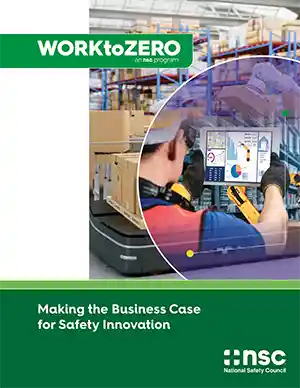‘Making the Business Case for Safety Innovation’
Highlights from an NSC white paper

The Work to Zero initiative at the National Safety Council
The mission of NSC’s Work to Zero initiative is to eliminate non-roadway workplace deaths by 2050. It focuses on educating employers on the benefits associated with technological safety enhancements in the workplace. Go to nsc.org/worktozero to learn more.
One of the biggest barriers to implementing safety technologies is financial constraints, especially in industries with low margins.
However, broader use of safety technology can save money and help prevent workplace deaths in organizations large and small, research from the National Safety Council’s Work to Zero initiative shows.
In its recently published white paper, “Making the Business Case for Safety Innovation,” NSC highlights the benefits of eight key technologies and provides safety and health professionals a “quantifiable foundation” for developing a business case for safety innovation. Here’s a quick overview.
Eight key technologies can help make workers safer:
Autonomous mobile robots for material handling
What are they? Sensor-enabled robots that can understand and move through an environment without the direct oversight of an operator or being on a fixed, predetermined path
Their benefits: Decreased ergonomic risks and material handling-related injuries, along with improved efficiency and productivity of material handling activities
Fatigue monitoring wearables
What are they? Wearable devices that monitor vital bodily metrics in real time to measure worker fatigue
The benefits: Improved fatigue management, as well as reduced absenteeism, presenteeism and health care costs
Lone worker mobile apps
What are they? Mobile device applications that are used for workplace violence reduction, predominately for employees who work by themselves without close or direct supervision
Their benefits: Improved lone worker monitoring, emergency response times, critical event management and communications
In-cab solutions for fatigue monitoring
What are they? In-vehicle camera-based driver monitoring systems that detect fatigued and distracted driving and then alert drivers and supervisors to real-time risks
Their benefits: Reduced fatigue-related vehicle incidents and associated property and vehicle damage costs
Permit to work software
What is it? Digital workflow and content, which enable operations and safety managers to apply an approval process that manages risks relating to hazardous work activity and speeds up the process of signing off on jobs
The benefits: Decreased risk onsite via verification of credentials, along with enhancing risk management, hazard mitigation and operational visibility
Proximity monitoring wearables
What are they? Fixed or wearable sensors that detect the location of nearby objects without physical contact, warn of impending collisions, and alert employees of hazardous situations
The benefits: Reduced transportation or contact-related incidents between employees and machinery/equipment, as well as property/infrastructure damage and replacement costs
Virtual reality for digital training
What is it? VR devices that immerse a user in an environment that’s entirely computer generated but allows the worker to navigate the environment as if physically there
The benefits: Increased training retention, impact and engagement; provision of safe training environments for high-risk work
Drones for confined space
What are they? Unmanned aircraft managed by a ground-based controller that can be leveraged for confined space inspections
The benefits: Risk eradication or mitigation by decreasing the demand for worker-led confined space inspections, plus increased efficiency and improved quality/accuracy of inspections
Building a business case involves 5 steps
Although identifying technologies that suit an organization is vital, it isn’t the only aspect safety pros should consider when developing the business case for safety innovation.
Multiple steps must be completed before companywide implementation can occur.
First, the employer must determine their business goals – reviewing how technology can fit into the strategic plan and ongoing initiatives. Management looking to substantially reduce incidents in the workplace often seek technological enhancement as a route toward achieving this objective.
Five steps to building a business case:
- Define business goals and operational capabilities
- Assess digital readiness and consider management-of-change factors
- Identify possible safety technology solutions
- Determine the return on investment for safety compared with “business as usual”
- Build a business case for safety innovation
Calculators can help you determine ROI
Employers are continuously seeking to understand when an investment will yield a positive net return and reach the expected break-even point. Both can be empirically estimated using an ROI calculator.
ROI calculators provide a vital component of the case by quantifying not only the costs, but also the broader safety benefits gained through investment.
ROI calculators for technological investment use validated assumptions regarding the expected percentage reduction in the incident rate because of the investment. Small to medium-sized organizations in particular may find value in using an ROI calculator because they often deal with a more limited budget.

Using ROI calculators as a tool, safety pros can better communicate the value of incorporating high-impact technologies to mitigate key risks and prevent fatal incidents. NSC has developed the Employer Investment Calculator – available on nsc.org – to help safety pros build the business case for implementing safety technology.
Post a comment to this article
Safety+Health welcomes comments that promote respectful dialogue. Please stay on topic. Comments that contain personal attacks, profanity or abusive language – or those aggressively promoting products or services – will be removed. We reserve the right to determine which comments violate our comment policy. (Anonymous comments are welcome; merely skip the “name” field in the comment box. An email address is required but will not be included with your comment.)


